|
This latest collection of horror-tinged thrillers from Eureka features four examples of what Stephen Jones and Kim Newman rather neatly identify as non-aligned horror, a term they coin to describe stand-alone movies that did not become part of a franchise, and with one notable exception did not feature creatures or characters that also appeared in other movies. In the case of the some of the more memorable supporting characters, that's actually a shame, but then that's just me. The quality here is consistently high – indeed, there's not a film here that I didn't enjoy immensely, making this quite possibly my favourite Eureka horror collection to date, despite strong competition from earlier titles.
A quick note. The films and the special features have been covered in the order in which they appear in this set rather than chronologically, with Murders in the Zoo and Night Monster being on disc one, and Horror Island and House of Horrors on disc two.
| MURDERS IN THE ZOO (1933) |
|
It's one thing to be confronted with an opening sequence that genuinely shocks you in a modern day movie, but quite another to be similarly affected by one made in Hollywood in the early days of sound cinema. So much horror water has passed under the bridge since then that what disturbed audiences in the 1930s can often seem almost quaint today, admirable for its artistry and the genre trends that it established, perhaps, but jarring? Hardly. But every now and then, a sequence from a film made before the Production Code put its censorial foot down still has the power to give even a modern audience a jolt, in part because we just don't expect to get one from a work of this vintage. Such a sequence opens the 1932 Paramount horror, Murders at the Zoo, one that caused me to audibly yelp when I first saw it on TV many years ago. Decades later, I could recall next to nothing else about the film, but still vividly remember that opening.

Coming back to it, I wondered if it really was as impactful as I remember. You'd better believe it. In a rare case of restraint on my part, I'm not going to get into specifics so that newcomers can experience this gloriously grisly sequence for themselves. I will reveal that it's the result of a grim punishment meted out on a jungle expedition by wild animal collector Eric Gorman (Lionel Atwill) to a man named Bob Taylor (Edward Pawley), who had the temerity to try and kiss Gorman's wife Evelyn (Kathleen Burke). A short while later, Gorman has returned to camp and scraps of Bob's clothing are found by natives amidst evidence that he has been eaten by tigers. Clearly, Gorman is a dangerously jealous man who only the most foolhardy would dare to cross. Enter Roger Hewitt (John Lodge), who on the steamship journey back to America is revealed to be having an affair with Evelyn, one that the two hope will culminate in Evelyn divorcing Eric and marrying Roger instead. Considering what he did to the unfortunate Bob Taylor (I'm still not telling), heaven knows what a man like Gorman would do to Roger if he was to even suspect the affair was taking place. The worrying thing is, he seems to know more about it than he's electing to let on, and doubtless has something deeply unpleasant planned for his wife's young lover.
Meanwhile, back on home turf at the Municipal Zoo to which Gorman is heading, amiable zoo chief Professor Evans (Harry Beresford) is checking the credentials of a man named Peter Yates (Charlie Ruggles), who has applied for the role of Publicity Officer, and I'm presented with the only aspect of this otherwise wonderfully sadistic little film that I found myself secretly wanting to slap. Yates is that all-too common aspect of many a horror movie of the 1930s, the comedy relief, and just how funny you find him as will be a matter of personal taste. On the commentary track, genre experts Jonathan Rigby and Kevin Lyons admit to rather enjoying his contribution. I have to confess that I did not. For me, this is humour whose ties to music hall comedy have really dated it, and there's an awful lot of Ruggles' verbal and physical buffoonery, including overly terrified reactions to almost every animal he encounters, to wade through during the first third of the film. Providing some character relief are young biochemist and toxicologist Dr. Jack Woodford (Randolph Scott), and Professor Evans' daughter Jerry (Gail Patrick), who is engaged to Jack and works as his assistant. As the film's untainted good-looking young couple, they are destined to play a significant part in in the film's second half, when the mysteriously top-billed Ruggles effectively becomes a background character.
Anyway, back to the story. For some reason, Evans hires Yates on the spot, and when Gorman arrives with his menagerie and is told by Evans of the zoo's current financial problems, Yates' first suggestion is that they hold a fundraising dinner for the local gentry in the zoo's main enclosure, where the guests would be surrounded by the caged beasts of the jungle. Frankly, it sound like a bonkers idea, but both Gorman and Evans give it the thumbs-up, so invitations are thus sent out and Gorman elects to pay Roger a special visit to personally invite him. He arrives unaware that Edith is hiding in the man's bedroom, but despite spotting her lipstick on a teacup and even toying with her carelessly placed passport, he elects not to show his hand at this time. During the dinner itself, however, Roger is suddenly shocked into a catatonic state, and a quick examination by Jack reveals that he has been bitten by a deadly black mamba snake that was donated to the zoo by Gorman and that has escaped its cage. All, however, is not quite what it seems.
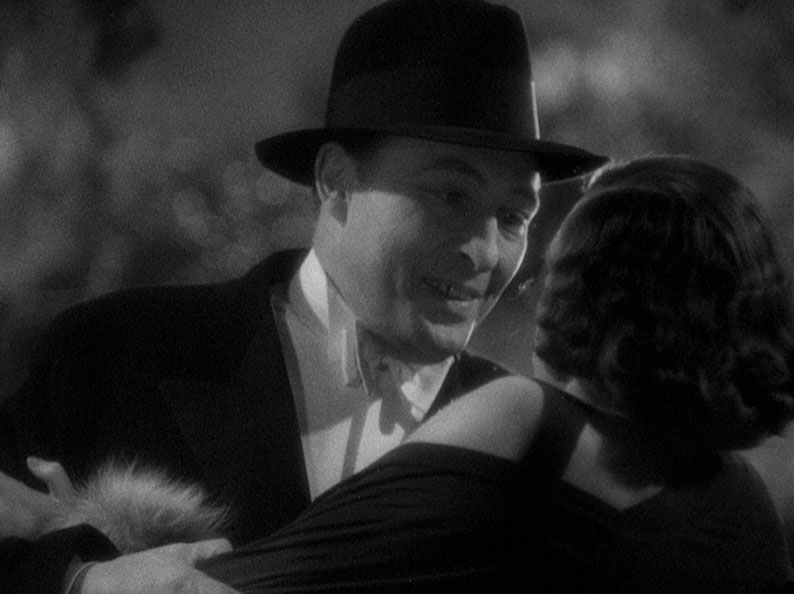
Irritated though I may have been by Yates, just about everything else about the film still really clicked for me, not least it's pre-Code willingness to go places that would soon be forbidden territory for American movies. By the halfway mark, there really is a sense that just about anyone could suffer an unpleasant death at Gorman's hands, and while we all know that he will eventually get his comeuppance, when it comes it's an appropriately serpentine doozy. The young Randolph Scott is good-looking and cheerfully driven as Jack, and as the climax kicks off, Gail Patrick comes into her own as Jerry, kicking against the genre fondness for showing frightened young women in peril by taking instant affirmative action in a moment of crisis and refusing to let anyone stand in her way. But stealing almost every scene is Lionel Atwill, who is wonderfully and nastily villainous as Gorman, behaving like the predator the almost anthropomorphic title sequence casts him as by verbally toying with his prey before delivering the fatal blow. His line delivery is often delicious, and just by throwing someone a look or pausing for thought his evil intentions are written all over his expressive face. He's well served on this score by a smart screenplay by Philip Wylie and Seton I. Miller (with uncredited additional dialogue by Milton Herbert Gropper), while rarely-discussed director A. Edward Sutherland avoids show-off technique to focus on keeping the story moving at a breathless lick.
It's always pleasing when you revisit a film that made an impression on you in your younger days and find it still delivers, and that's absolutely true of Murders in the Zoo. It has occurred to me that my issues with Ruggles may be down in part to the dark expectations I had for the film due to the impact that opening scene had on my in my younger days, expectations that had no room for broad comic relief, and that for some it will provide a little welcome respite from the story's nastier aspects. That said, even the comedy pushes its luck here, notably when Yates is given the fright of his life when he is trapped in a cage with the deadly black mamba. After Jack snares the snake and Yates falls to the floor in a fearful faint, Jerry runs over in a panic and begs him to say something, to which he awkwardly responds, "Is there a good laundry in this town?" As far as I'm aware, that's the only shit-my-pants gag in 30s Hollywood horror.
In the bright of day, a turban-wearing Indian approaches the large iron gates of a stately home, which are opened by a crochety gatekeeper, who wonders why the man talks to the frogs since they're unlikely to tell him anything they knew. Fair point, I'd say. The Indian enters the house, then quickly secretes himself in the shadows when he spots a woman scrubbing away at the stairway carpet. She's interrupted in her task by a younger woman, who, from the conversation that then unfolds, seems to be having some emotional issues, or maybe she is being gaslighted into thinking she has. Yes, we've seen this situation in movies many times since. When the younger woman reveals that she's asked renowned psychiatrist Dr. Harper to come to the house and examine her, the older woman is startled and insists that she cancel the visit. After all, she reminds her, doctors King, Timmons and Phipps are due here soon. As the argument becomes more heated, the older woman orders the younger one to go to her room. All the while, the unseen Indian watches on from the shadows below.
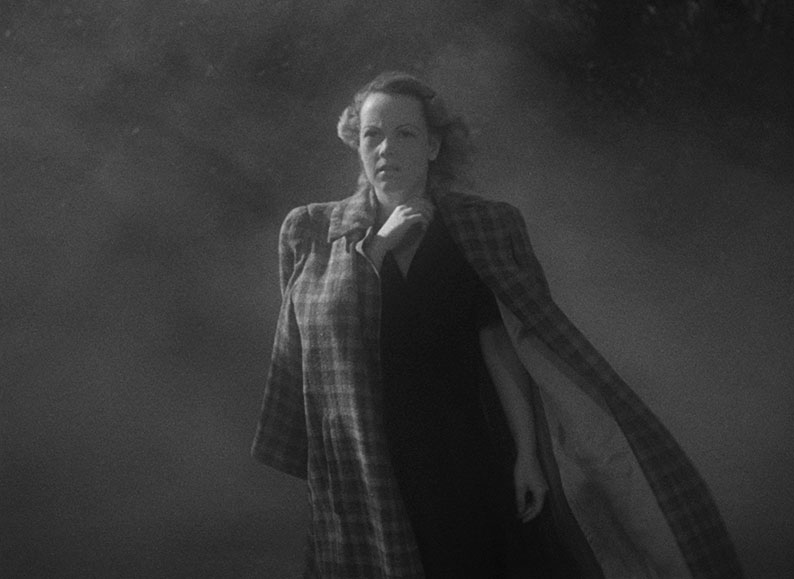
When the two women head off, a maid appears, and when she spots the stain on the carpet she heads straight downstairs, picks up the phone and asks to speak to police constable Cap Bates. When she gets through to him she reiterates that there's something funny going on here that he should look into "before it's too late." Before she can get to specifics, a butler appears, cuts the call off, and warns her that it's considered bad form to gossip. When the maid then announces she's quitting, the butler attempts to restrain her, but lets her go when a sleazy hulking bulk of a chauffeur intervenes. The butler tells the chauffeur that he intends to report him to someone named Mr. Ingston, but the chauffeur is unimpressed, retorting that he and Mr. Ingston have a special understanding. As the chauffeur and the maid depart and the butler heads upstairs, the Indian finally emerges from the shadows to suggest that it might be best to say nothing of this to Mr. Ingston. We're almost ten minutes in, and I genuinely don't have a clue what is going here or who these people are, and yet that very fact has ensured that I'm already hooked and keen to learn more.
Things become a little clearer over the course of the next ten minutes of screen time, only for these early mysteries to be replaced by a handful of new ones. We soon learn that the younger woman's name is Margaret Ingston (Fay Helm), whose considerably older brother Kurt (Ralph Morgan) has been left severely disabled after surgery performed by doctors King (Lionel Atwill), Timmons (Frank Reicher) and Phipps (Francis Pierlot) failed to cure his unspecified condition. The faux-Indian gentlemen is Agor Singh (Nils Asther), who is resident at the house and is assisting Kurt to help himself by teaching him an ancient Hindu technique that draws on the untapped power of the mind. The woman ordering Margaret around is housekeeper Sarah Judd (Doris Lloyd), the perky maid is Milly Carson (Janet Shaw), the butler is Rolf (Bela Lugosi), and the gatekeeper has somehow landed the mechanical name of Torque (Cyril Delevanti).
And then there's chauffeur Laurie (Leif Erickson), and I'm going to have to pause here to say a little more about this delightful fellow. Laurie is – now how can I put thus? – a sleazy scumbag of the lowest order, one who presumably only landed the job in the first place because he's big and strong enough to carry Kurt wherever he needs to go, a sort of bargain basement equivalent of Mr. Alexander's bodybuilding manservant Julian in A Clockwork Orange. He behaves like the most egotistical member of Marlon Brando's bike gang in The Wild One, complete with an ever-present cocktail stick in his mouth (seriously, what was that ever about?), and stares at every woman he sees with the filthy leer of a serial rapist, a crime that I have little doubt he is all-too familiar with. And when I say he targets any woman I mean it – at one point he even makes a play for the frosty Mrs. Judd, who unsurprisingly reacts to his advances with horror. Actually, to their credit none of the women here finds his behaviour even remotely charming, but that doesn't stop him for a second. He even pulls the car over whilst driving the newly quit Milly to town to try and force himself on her, and she only gets away because she runs into local man Jed Harmon (Eddy Waller) on his horse and trap.

Dr. Harper, on the other hand, kicks against the genre tradition of a well-intentioned pipe-smoking man with the young, female and attractive Lynne (Irene Hervey). She runs into trouble when her car breaks down on the road that night, but she's given a lift by local horror story writer, Dick Baldwin (Don Porter, who does smoke a pipe), who as old man Ingston's seemingly only friend just happens to be on the way to the house himself. I should probably also mention that there's been a murder in the area recently, one where the victim was strangled but a pool of blood of mysterious origin was found by the body. Local legend also has it that something strange and unpleasant stalks the misty woodlands at night, and its appearance is immediately preceded by the instantaneous cessation of croaking by the local frog population. Oh, and the real reason Laurie was driving to town was to meet doctors King, Timmons and Phipps at the station. They, it turns out, have been invited to visit the man they effectively crippled despite what all seem to agree were their best efforts, drawn there by Kurt's stated intention to make a large donation to the sort of medical projects they are all seeking funds for.
In essence, Night Monster is an old dark house murder mystery with an occult horror heart, an enticing hybrid firmly established when night falls and the guests are all firmly ensconced in the Ingston household. By this point, we're fairly certain that the unfortunate Milly has already fallen victim to whatever walks at night, and that Lynne caught a glimpse of the creature as she fled after her car broke down and she heard Milly's screams. Fog-shrouded exteriors are dripping with spooky atmosphere, and that sudden silencing of the frogs is as unnerving as the radio static that announced the invisible presence of unspeakable creatures in those terrifying early Silent Hill games. A niche reference, perhaps, but not for those who've played them. Journeyman director Ford Beebe does a spanking job with strong material from screenwriter Clarence Upson Young, and cinematographer Charles Van Enger really shows his worth in those misty exteriors and the moody lighting of the interior sets. What really surprises is the level of restraint on display, with all of the murders taking place off-screen and often revealed only when the victims are discovered by others. Even then, Beebe often opts not to show the whole body but a single fallen limb, leaning heavily into the murder-mystery aspect of the tale.
But the occult element is there and is on full display even before the halfway mark in the shape of a demonstration of his powers by Agor Singh for the assembled guests. I'm not going to get into the specifics of what he does because it's worth being surprised by, but will confirm that it's not going to win any plausibility contests. But you know what? Preposterous it may be, but as early supernatural horror movie concepts go it's hard not to love it just a little, especially given how neatly it's presented and how seriously it's taken by everyone present. Clearly this is going to be more than a decorative inclusion, and if you think the film is pushing its luck with the concept here, just wait until you see where it's later taken.
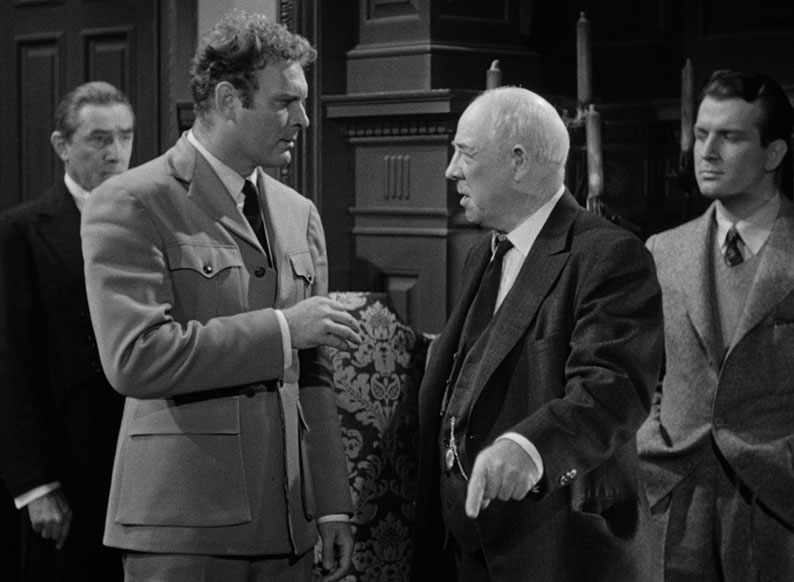
The cast is also really something here, and a prime reason why everything works as well as it does and the film as a whole is so entertaining. Despite being top-billed, Bela Lugosi is effectively a supporting player as butler Rolf, and peculiarly seems to drop out of the film before the end, leaving us teasingly uncertain of his character's fate. That said, he's on good form here, particularly in his subtler reaction shots, and it's often playfully uncertain where exactly where his loyalties lie. As Dick Baldwin, the young male character set up from an early stage as the one who is most likely to get the girl and make it to the end credits with her alive, Don Porter may not exactly have much depth but is a likeable presence nonetheless, though is easily outshone by his female counterpart Irene Hervey as Lynne Harper, whom I instantly suspected was the smarter of the two. The three doctors are all engagingly played, with Lionel Atwill's talent for confident bluster put to good use here, and while I may have nothing but contempt for the character, the fact that he so irked me is a testament to the sheer sleaziness of Leif Erickson's portrayal of lecherous chauffeur Laurie. Danish actor Nils Asther is moodily effective as Singh, despite the brownface aspect, and I liked Ralph Morgan's portrayal of the severely disabled Kurt Ingston, a role that could easily have been hammed up but is for the most part rather nicely underplayed.
However, it's in the supporting cast that my favourite three performances can be found. I enjoyed every brief appearance by Cyril Delevanti as sometimes uncooperative gatekeeper Torque, and Janet Shaw is so likeably animated as the confident Milly that I found myself wishing her character had not been killed off so quickly. But the actor I became the most fond of over the course of the story was Robert Homans as the town constable, Cap Beggs. Initially, it seems as if he's going to go the way of so many dopey policemen in horror movies when he brushes off Don's expressed concerns about whatever's going on up at the Ingston house, having clearly acted similarly to repeated calls from Milly. But once he gets going, his cheerless, bone-dry delivery repeatedly put a smile on my face, and despite his age, he refuses to be intimidated or bossed around by others, whatever their size or social standing. When he threatens to take the far larger and younger Laurie downtown and throw him in jail for non-cooperation, Laurie's tough guy response is to laugh and ask, "You and who else?" to which Beggs replies without altering the pitch of his voice one bit, "Just me," which unexpectedly puts Laurie in his place. But his newly discovered determination is best illustrated when he orders Rolf to bring all of the men in the house downstairs, despite the late hour. "I'm afraid they have retired, sir," Rolf informs him, then asks in a manner that feels just a little like a complaint, "Couldn't the investigation wait until morning?" to which Beggs responds almost matter-of-factly, "Yes it could. But it ain't going to." He then takes the long stick he is using to measure the size of his suspects' feet and tucks it into his trouser pocket like a used handkerchief. Others will disagree, but I could have happily watched another couple of murder mysteries with constable Cap Beggs running the investigation.
On a quiet dockland street at night, a sailor with a wooden leg is being followed in the shadows by a mysterious figure who dresses like the man in the Sandeman Port logo. When the sailor stops at a fishing supplies and excursion shop and tries the door, he is immediately approached by an unexpectedly good-natured beat policeman, who suggests he take a walk and sober up. The sailor assures the cop that he hasn't been drinking ("but that's an idea") and asks where he might find the shop's owner, Bill Martin, and is directed to pier five, where Martin and his pal are usually found hanging out at this time of night. "I have some news for him," Tobias cheerfully claims, "rare and interesting news."
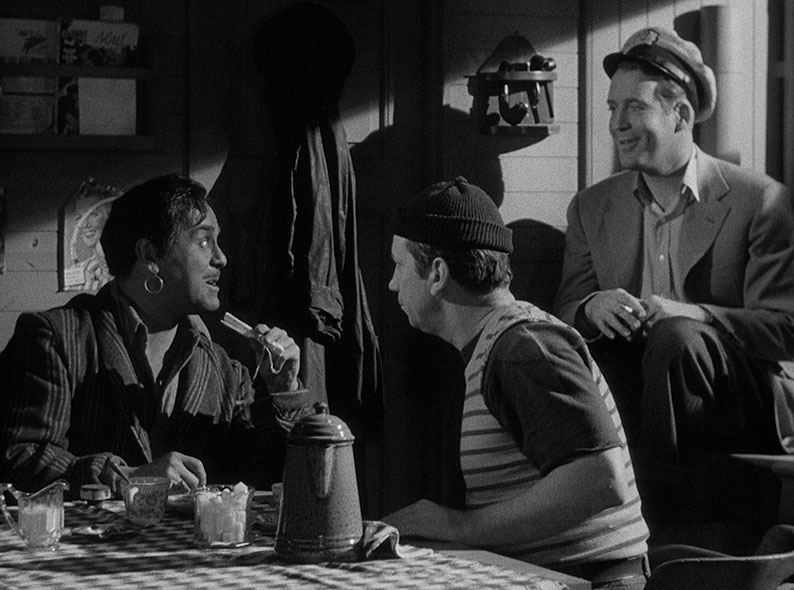
We're then introduced to Bill Martin (Dick Foran) himself, as he sits in the cabin of his boat contemplating his plan to produce condensed stuffing for Christmas turkeys, an idea that he claims to his unconvinced assistant Stuff Oliver (Fuzzy Knight – and yes, both the character and the actor names are for real) will be worth a million dollars. This, it turns out, is the latest in a string of hopeless wheezes that Martin has dreamt up in an attempt to pay off his mounting debts, the invoices for which he smilingly screws up and throws into the sea when they are plonked on his desk by the at-his-wits-end Stuff. Just after he does so, the two men hear a cry for help, and rush on deck in time to see the one-legged sailor and the man who was following him wrestling on the dock, a fight that concludes when the sailor is thrown into the water and the other man flees.
Bill and Stuff pull the Spanish-accented sailor out of the water and he introduces himself as Tobias Clump (Leo Carrillo) and identifies his mysterious pursuer as The Phantom (Foy Van Dolsen). Tobias has been searching for Bill because he's the owner of the small and remotely located Morgan Island, which he has discovered is the location of $20 million worth of buried treasure. He even has an ancient map pointing the way to its secret location, half of which was unfortunately stolen by The Phantom in the dockside struggle. His proposal is that if Bill will partner up with him and take him to the island, he will split the treasure with him fifty-fifty. Bill finds it hard to take the claim seriously, but is given cause to reconsider when the Phantom returns and boards the boat in an attempt to get his hands on the other half of the map. The three men give chase but The Phantom gets away, yet a short while later they spot what they think is him back on the boat and rush back to tackle him. Only after Tobias has knocked the interloper cold does Bill realise that he is not The Phantom at all, but his cousin George (John Eldredge), a financially secure playboy who wants to buy the bequeathed island from Bill for $20,000 to use, it is inferred, as a quietly located love nest. It's an offer that Stuff thinks Bill should accept but that the wily Bill is instantly suspicious of. "Well, that does sound reasonable enough, George," Bill tells him. "Coming from anybody else I might consider it." George leaves the offer open regardless, and pledges to return in a few days to see if his cousin has changed his mind.
The following day, Bill takes Tobias's half of the map to be authenticated by noted local cartographer, Professor Jasper Quinley (Hobart Cavanaugh), only to have his bubble burst when Jasper reveals that it's actually a top quality forgery, news he also broke to The Phantom the previous day when he paid him a visit. This nonetheless gives Bill a new idea for making money, and he immediately ropes Stuff and Tobias into helping him set up a treasure hunt excursion to Morgan island for $50 a head. The subsequent gathering of characters required to kick off the main story into gear begins when Bill's car has a minor collision with one being driven by the wealthy and headstrong Wendy Creighton (Peggy Moran), which leads to an argument that develops into a virtual definition of 'meet cute'. Bill eventually persuades Wendy and her hungover and couldn't-care-less suitor Thurman Coldwater (Lewis Howard) to sign up for the cruise, on which they are joined by cousin George, curious cartographer Jasper Quinley ("It is an adventure, isn't it?"), and a shifty-looking fellow with an as-yet unspecified ulterior motive named Rod Grady (Ralf Harolde) and his young wife Arleen (Iris Adrian). Just before they set sail, private investigator McGoon (Walter Catlett) shows up waving a court order to prevent Bill from sailing because of his claims that the castle located on the island is haunted are patently false, but is ultimately convinced by the smooth-talking Bill to join the party and look for evidence of his claims.
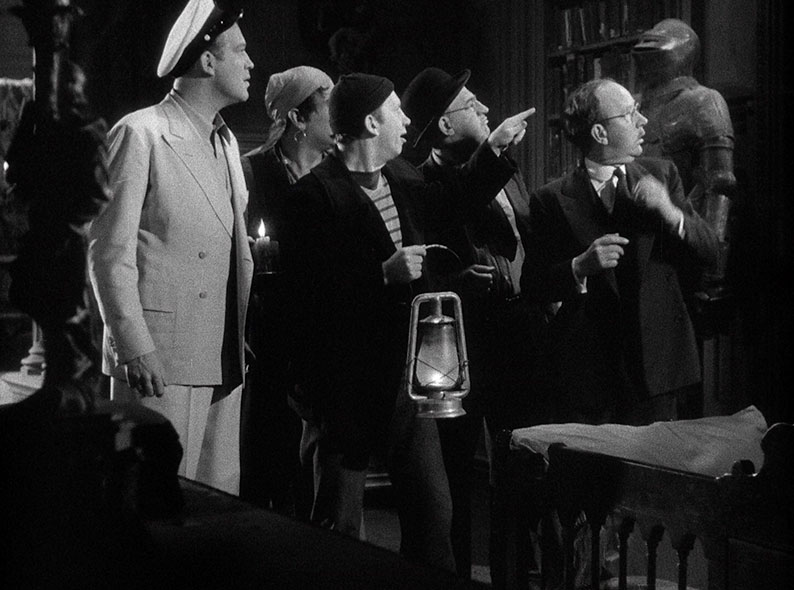
And so the scene and characters are set for what quickly moves into Old Dark House territory on the party's arrival at the island, and evolves over time into a take on Agatha Christie's And Then There Were None. There's little about the story and the characters that a fan of 30s and 40s genre cinema won't have seen before, and even the title is a little deceptive, suggesting the sort of horror movie that this mystery-thriller was never intended to be. As almost soon as they all enter the castle, we're shown that the spooky voice that echoes through the walls is being delivered by Stuff through a sound system that I'd love to know how the cash-strapped Bill was able to afford to buy and have installed, while The Phantom is shown to be behind the incidents that leave even Bill and Stuff scratching their heads. There also can't be many who watch Bill twice dodge a man he believes is a bill collector earlier in the film who won't guess that he will reappear later as the bearer of the sort of unexpected good news that rounds the story off.
A predictable mishmash of recycled components, then? Well, yes, in a way, but if that's what you have to work with and the budget and shooting schedule are tight, then this is how you go about it. As directed by George Waggner, who in the very same year also made The Electric Man and won the hearts of horror fans worldwide with The Wolf Man, Horror Island thunders forward at breakneck speed, cramming a good 80 minutes of plot and character scenes into just one hour of busy and consistently entertaining screen time. The foundations are set by a tightly structured screenplay by Maurice Tombragel and Victor McLeod (from a story titled Terror of the South Seas by Alex Gottlieb), which is brought energetically to life by a belter of an ensemble cast, each member of which is given a staple character to work with and gives it their all. Dick Foran, who shot to fame as the Singing Cowboy, makes for a most engaging male lead as Bill Martin and is well-teamed with perennial sidekick Fuzzy Knight, (initially) confident heroine Peggy Moran, and Leo Carrillo as the expressive, likeable and ever-optimistic Tobias Clump. Oddly enough, for me the highlight of a fine supporting cast is the one who has the fewest lines and the least amount of screen time. As Wendy's bored suitor, Thurman Coldwater, Lewis Howard had me laughing out loud at his every appearance, from his sleepy request for Stuff and Tobias to go away after they mistake him for a corpse, to his comically half-heated goodbye wave to Bill as he exits his shop. It thus felt only appropriate (spoiler alert! – hop to the next paragraph to avoid) that the film's parting iris close should be of Thurman as he deals with disappointment by taking another nap. Once again, I found myself wishing that a minor character had a bigger role to play or had made a reappearance in subsequent films.
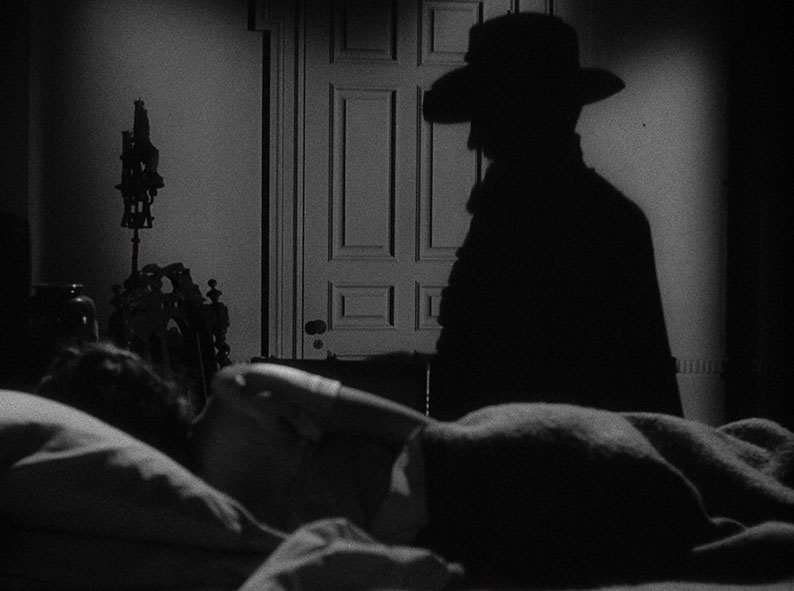
The news that Horror Island was shot in just 13 days on a budget of just $93,000 genuinely dropped my jaw, as despite the borrowings and reliance on stock characters, nothing about the film feels compromised or cheap. This is particularly true of Elwood Bredell's consistently gorgeous monochrome cinematography, particularly his expressive and atmospheric use of light and shadow. Indeed, there are times when you could almost think you're watching an early film noir, a genre in which Bredell would later make his name with films like The Phantom Lady (Robert Siodmak, 1944), Lady on a Train (Charles David, 1945), Smooth as Silk (Charles Barton, 1946) and the masterful The Killers (also Siodmak, 1946). It's just one element of many that belies the rapid shooting schedule (and, apparently, punishingly long, union rule-breaking days) in a film that may be heavy on its borrowings but which feels planned and rehearsed to perfection by a cast and crew committed to making the very best film they could from unoriginal but still smartly written material.
Marcel De Lange (Martin Kosleck) is a struggling sculptor in need of a break, which he looks set to get when art collector Samuels (Byron Foulger) brings renowned art critic F. Holmes Harmon (Alan Napier) to Marcel's workshop to view his latest creation. When the hopeful Marcel unveils the work, however, Harmon pompously describes it as "pure unadulterated tripe, with an overtone of sheer lunacy." He doesn't stop there, insisting that he loathes it and wondering why Samuels would want to clutter up his otherwise rather nice art collection with "this abomination." He's just getting going again when Marcel furiously cuts him short and chases the two men out of his house with a bread knife. Utterly depressed, he smashes his sculpture and walks down to the riverbank with the clear intention of taking his own life. Just before doing so, however, he sees a figure in the water below struggling to climb out onto the dock. He rushes down and assists the now unconscious man (Rondo Hatton), and is instantly inspired by his bulk and primitive facial features. "Magnifique," he says to himself as all thoughts of suicide vanish, "the perfect neanderthal man."
Marcel takes the man home and treats his injuries, and when the man wakes, he is genuinely surprised that anyone would choose to help him. "You know who I am?" he asks as a newly invigorated Marcel serves him breakfast in bed, but Marcel cares not and instead requests that the man agree to pose for a statue. The man is still confused. "You ain't afraid of me?" he asks, but again Marcel is not remotely phased. "Why should I be afraid of you?" he asks. "I owe you my life," and a friendship between the two men is instantly born. After his first sitting as a model for Marcel the following evening, however, the man puts on his coat and jacket and wanders the streets until he comes across a lone woman, and when she sees his face and screams, the man grabs her and snaps her spine. Surprisingly, when he reads about the death in the paper the following day, Marcel quickly cottons on to the likelihood that his house guest was responsible, and begins cursing Harmon and his spiteful and destructive words, claiming that it is because of him that the two men are struggling to find enough money to eat. He makes sure to specify that Harmon resides in an office block known as the Dover Tower, and angrily claims that he would tear him apart with his bare hands if he was able. "And we are helpless to do anything about it," he claims in mock despair, at which point his guest calmly gets to his feet, puts on his hat and coat, and heads out in the direction of Dover Tower…
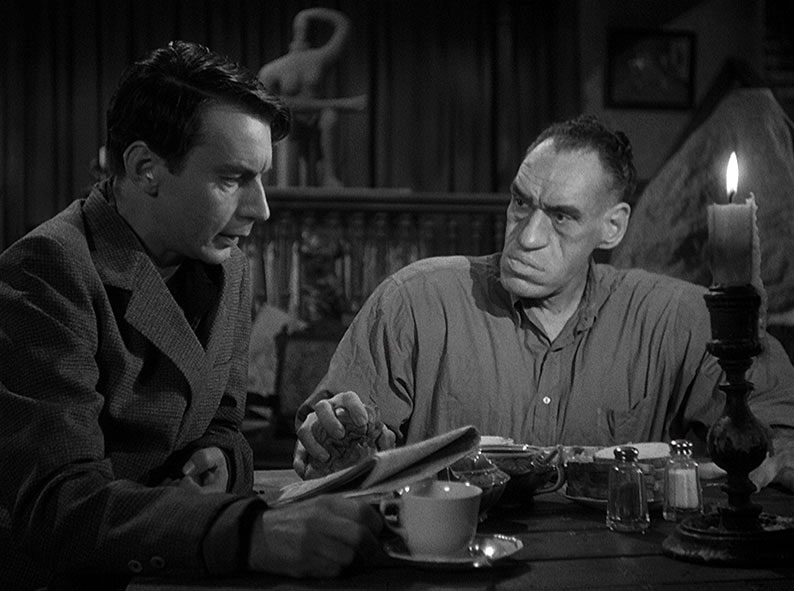
Although theoretically the familiar tale of a vengeful individual who uses a monster under his control to dispatch his enemies, the commercially-minded but misleadingly titled House of Horrors kicks against the conventions of this trope in a number of ways. The first is that the individual in question is presented from the moment we meet him in a sympathetic light, a struggling artist barely able to feed himself and the house cat that is his only friend. As played by Martin Kosleck, he's instantly likeable, and screenwriter George Bricker, director Jean Yarbrough and actor Alan Napier (later to play Alfred the Butler in the Batman TV series) pull no punches in portraying his nemesis, Holmes Harmon, as a pompously self-important git. It's thus hard not to feel just a little pang of cathartic satisfaction when Marcel points his murderous guest in this dreadful man's direction.
Let's talk about this guest for a second. First up, he's played by Rondo Hatton, who achieved a degree of cult status over the years and whose intimidatingly unconventional appearance was not the result of a make-up job by the great Jack Pierce (who did work on this film), but a medical condition known as acromegaly that is believed to have been triggered by exposure to poison gas during the First World War. And despite his appearance, Hatton is presented compassionately from the moment we meet him. The victim of an attack or a suicide attempt (it's never specified), he is genuinely startled that Marcel is not in any way intimidated by a size and facial features that we can presume have prompted others to scream and run away in terror. In some ways, Marcel and his guest prefigure Frederick Treves and John Merrick in The Elephant Man – both Marcel and Treves meet their respective disfigured unfortunates by chance, both treat them with the sort of kindness and respect that they have previously been denied. Both also have ulterior motives that could ultimately have a positive impact on their careers. Treves genuinely wants to help Merrick, but wastes no time in presenting him to a hall full of his colleagues as a medical curiosity, and Marcel wants his guest to model for what he believes with be his artistic masterpiece. Only when he realises that this man has the capacity to kill without conscience or remorse does it occur to Marcel to put him to a more nefarious use.
So what of the stranger? The key line when he wakes in Marcel's spare room is "You know who I am?" the suggestion being that he is either famous or infamous enough for Marcel to be expected to recognise and have a probably negative opinion about him. And although a short while later the police are speculating that these murders are the work of a notorious and thought-dead homicidal killer known as The Creeper, a contemporary audience may already have recognised the stranger as such, this being the second film in which Hatton played this role after its debut in the 1944 Sherlock Holmes mystery The Pearl of Death. He returned again as The Creeper in the 1946 horror thriller The Brute Man – tragically, Hatton died before either that or House of Horrors made it to the screen. Although not a professional actor, Hatton does a fine job here of portraying The Creeper as a simple man who has suffered a complete morality bypass, and the fact that he is presented not as a monster but an ordinary man when we first meet him makes his subsequent character arc feel all the more tragic. We feel for him when he is rescued and treated with civility by Marcel, and I for one was secretly egging him on when he pays a lethal visit to the awful Harmon, aware by this point that he was being manipulated into committing murder by the man he now regards as his friend. But in-between those two scenes is the one where he kills a woman for nothing more than letting out a scream at his intimidating approach, a crime that only a real-life monster would condone.
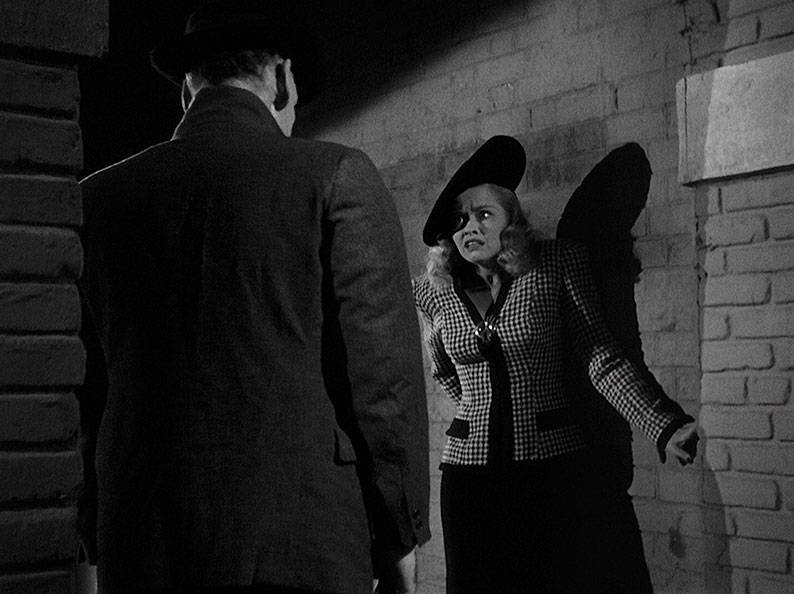
By the time Harmon gets his comeuppance, the character pool has expanded a little to include Joan Medford (Virginia Grey), a sassier, prettier and altogether fairer art critic than Harmon. She just happens to be dating artist Steven Morrow (Robert Lowery), who takes a week to paint a picture that illustrators I've worked with could bang out in a couple of hours. And then there's Police Lieutenant Larry Brooks (Bill Goodwin), who's investigating the murders and quickly develops a thing for Steven's pretty young model Stella McNally (Joan Fulton). It's our Stella that prompted the second of a couple of questions I found myself asking about content that the filmmakers theoretically shouldn't have been able to include. As a film released in 1946, it would have been subjected to the no-quarter-given censorship of the Production Code, which as noted at the very start of this review, had a whole list of things we now take for granted that were considered no-go areas at that time. And one thing you just did not see in Hollywood films of the day were sex workers, yet there's absolutely no question whatsoever that this is the profession of The Creeper's first victim. Hell, the credits even list her as "Lady of the Streets," a euphemism for the profession that was still in widespread use in my younger days. And then there's our Stella. It's not that she's even close to naked, posed as she is with a tennis racket and dressed in shorts and a short halter top. And while maybe, just maybe, it's the way that the seams in the halter top are cut and sewn, but on first (and frankly second and third) glance, it still looks suspiciously like her nipples are visibly attempting to burst through the cloth. It matters little if in reality they are or they aren't, as it was always all about what it looks like with the Production Code. I can thus only assume that head honcho Joseph Breen on sick leave on the day this film was submitted, and that the job fell to a more open-minded assistant who had a serious thing about Miss Fulton.
As Marcel's desire to punish those who have crossed him leads to more killings by The Creeper, he is gradually transformed from a understandably upset victim into a vengeful madman, convinced of his own genius and the innate inferiority of those who deride him and his work. This moves the film into more conventional territory, with the murders committed by a facially deformed killer at the behest of the only guy in the cast with a foreign accent. Oh, how things have changed. Yet later, when Joan starts snooping around Marcel's workshop for a news story and is daft enough to borrow a sketch that he has done of The Creeper – who watches her every move from a hiding place that would frankly conceal no-one – my loyalties were once again intriguingly divided. On one hand, I feared that Joan would see The Creeper and he would react by killing her, but on the other I worried that she would learn just enough to expose him for who he is and help engineer his sadly inevitable demise. I really liked The Creeper. If only he wasn't a heartless serial killer.

While it does ultimately play to convention in places, House of Horrors – which is also known under the more pedestrian title of the story by Dwight V. Babcock on which it is based, John Medford Is Missing – still stands out from the crowd through the decision to paint its nominal monsters in such compassionate and frankly human colours from an early stage. It helps no end that Martin Kosleck delivers what is far and away the film's best and most nuanced performance as Marcel, making the character so likeable that his descent into vengeful madness left me with a sense of loss for the man that could and maybe should have been. On this score, the film shares some DNA with Douglas Hickox's 1973 Theatre of Blood, in which a group of theatre critics are systematically killed in the manner of deaths from Shakespeare plays by an actor they effectively drove to attempt suicide. With that in mind, I couldn't help wondering if the exaggerated nastiness of Harmon and his subsequent murder was a sign that screenwriter Bricker and director Yarbrough weren't trying to get something off their chests.
It's clear that all four films have been restored, and while I don't have the precise details of the individual restorations, the up-front Universal logo on both discs and each of the films does suggest that this was the work of that studio. Apologies to Eureka if I'm wrong on that score. As the oldest of the films here, Murders in the Zoo is the least crisp when it comes to image sharpness, and it does still display some small signs of wear, including a few thin but clearly visible scratches. In other respects, though, it's in good shape, being largely clean, stable in frame, and boasting a nicely balanced contrast range. The sharpness and fine detail definition are stronger all round on Night Monster, only softening a little on effects shots that were doubtless created using multiple exposures, a process that inevitably impacts on sharpness. The tonal range of the contrast is excellent here, with solid black levels and a lively greyscale, and the film grain is finer here than on the first film. It's a similar story for both Horror Island and House of Horrors, both of which are in most impressive shape, with nicely graded contrast, strong black levels (especially important for Horror Island's noir feel), crisp rendering of detail, and a fine film grain. There are a couple of briefly seen minor scratches on House of Horrors, both otherwise the image on both films is clean. All four films are presented in their original Academy aspect ratio of 1.37:1.
All four films have Linear PCM 2.0 mono soundtracks, and once again Murders in the Zoo shows its age more obviously than its comrades, largely in its narrower tonal range and the slightly fluffier feel to the sound in general. Dialogue is still always clear, however, and there's no obvious signs of damage or background hiss. Clarity improves on the later films, which also boast a slightly wider tonal range on the dialogue, effects and music. There's little evidence of wear and damage, though there are some small pops and background crackle on a couple of scenes in Night Monster.
Optional English subtitles for the deaf and hearing impaired are available on all four films.
MURDERS IN THE ZOO
Audio Commentary by Kevin Lyons & Jonathan Rigby
Encyclopaedia of Fantastic Films and Television website editor Kevin Lyons is once again teamed with American Gothic and English Gothic author Jonathan Rigby for a fact and opinion-packed examination of Murders in the Zoo, a film they nicely summarise as "an outstandingly sadistic addition to 30s horror." They praise the film for is top-notch screenplay and opine that the startling opening sequence represents an "anything goes" mentality that would soon be crushed by the enforcement of the Production Code. They offer justification for the early sequence that showcases the zoo animals at some length, and provide a history of the zoo in which the much of the film was shot, as well as details on the actors and the production itself. Unlike my good self, they are rather charmed by the comical antics of Charlie Ruggles, about whom they have quite a bit to say, and do point out that despite the new, pre-film Universal logo, this was actually a Paramount production.

Stills Gallery
12 screens of posed promotional stills, lobby cards and posters, including a French one under the title Le serpent mamba (The Black Mamba).
NIGHT MONSTER
Audio Commentary by Stephen Jones & Kim Newman
Sharing the commentary duties in this set are novelist and critic Kim Newman and writer and editor Stephen Jones, who describes Night Monster up front as one of his favourite Universal horror movies, while their research suggests that this Blu-ray release may be the film's British debut. As ever with these two, the commentary is a packed one, with information on the film and its makers alternating with opinion on the performances, the filmmaking, and the effectiveness of individual scenes. They remark that the central supernatural conceit is simultaneously bonkers and cool, Jones recalls thinking that the moment the frogs suddenly stop croaking was the creepiest thing ever when he was a teenager, and both praise the strong female cast, the cinematography, the character detail and the direction. They also note that there's not a wasted moment in the film – "I could have done with another ten minutes of this," says Newman at one point.
Trailer (1:09)
Sensational captions and some well-chosen clips make this a surprisingly intriguing sell. I really liked the way the cast names come up on screen, so much so that I'm already planning to nick the idea for a future video project.
Stills Gallery
12 screens of promotional photos, artwork and posters.
HORROR ISLAND
Audio Commentary by Kevin Lyons & Jonathan Rigby
Lyons and Rigby are back for a film whose artistry they admire, but whose second-hand content they are slightly more critical of, though always with affection and good humour. They reveal that the film was released a seemingly impossible 25 days after shooting began, that shooting days were long and hard, and that atrocious weather caused problems for the exterior filming. Details are provided on all of the actors, some of whose memoires are quoted from, sets are identified that were reused from earlier films, and praise is heaped on the work of cinematographer Elwood Bredell. They also point out a scene that makes no sense in the context of how the plot later unfolds and which thus counts as a cheat on the filmmakers' part. I'll give them that one.
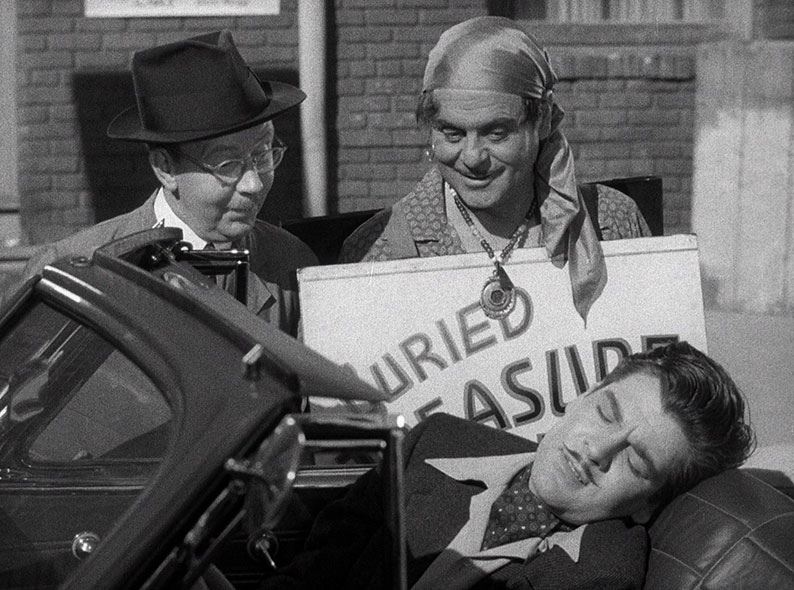
Trailer
"Terror pays a visit" in a typically unsubtle but rather effective sell, which has a wider variety of creative shot transitions than you'll find on a home movie from a video newcomer who's just got their hands on iMovie for the first time. Full marks for making the word "shivered" actually shiver, and while the condition of the trailer is not bad, there's an interesting, fault-created sparkle to the highlights that almost looks deliberate.
Gallery
35 screens of utterly gorgeous quality monochrome promotional photos, a couple of posters, and three lobby cards.
HOUSE OF HORRORS
Audio Commentary by Stephen Jones & Kim Newman
This second commentary by Jones and Newman kicks off with the pronouncement that House of Horrors is one of their favourite late Universal horror movies, and the fact that in terms of its pacing it moves like a rocket. Both believe that Martin Kosleck is the true star of the film (with them on that), and both are as mystified as me when it comes to how some of this film's content made it past the Production Code enforcers. As expected, Rondo Hatton is discussed, as are the other two Creeper movies, and as someone who has written about him, Kim Newman has quite a bit to say about director Jean Yarborough. There's plenty more, and once again it's an absolute must-listen.
Trailer
A functional trailer in the usual mould that really pushes The Creeper as the star of the film, despite Rondo Hatton's bottom-of-the-cast list placement.
Gallery
42 screens of posters and production stills, including some always welcome behind-the-scenes shots, and a fair few designed to make Rondo Hatton look ghoulish and murderous.
Also included with the first 2000 copies of the release version is a Limited Edition Collector's Booklet featuring new writing by Craig Ian Mann and Jon Towlson, but this was not available for review.
I love these multi-film horror Blu-ray box sets from Eureka and this may well be my favourite yet. I hugely enjoyed all four titles in this collection, for their writing, their performances, their technical handling, their artistry, and their sheer enjoyability as entertainment. As far as I'm concerned, the films alone in such fine condition would be worth the asking price, but the excellent commentary tracks really are the icing on the cake. Highly recommended.
|